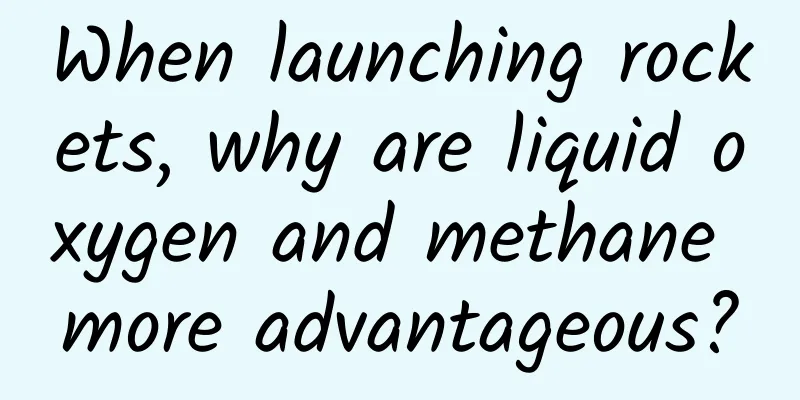When launching rockets, why are liquid oxygen and methane more advantageous?

|
Written by reporter Duan Ran Editor/Chen Yongjie New Media Editor/Wang Shan Image provided by Blue Arrow Aerospace (except for those with signature) At 9 a.m. on July 12, 2023, at the liquid oxygen-methane launch station at the Jiuquan Satellite Launch Base deep in the desert, a slender figure rose from the launch pad and shot into the sky like an arrow in the rising smoke. In the rocket launch command and control center, all the staff members watched intently as it disappeared into the blue sky with its tail flame. Soon, the announcement of "Suzaku-2 was successfully launched" was like a thunderclap, breaking the slightly oppressive silence, and warm applause resounded throughout the control room. ▲Launch Command Center of the Blue Arrow Aerospace Suzaku-2 carrier rocket (Photo: Ren Xiaopeng) On this scorching summer day, this medium-sized carrier rocket named "Zhuque-2" Yao-2 is definitely the brightest star at the Jiuquan Satellite Launch Center. It is the proud product of my country's private aerospace enterprise "Blue Arrow Aerospace". From ignition to successfully sending the satellite into the predetermined orbit, "Zhuque-2" took 760.88 seconds. Behind these 760.88 seconds, there are more than 100 hours of hard work since the rocket completed the transfer and erection work on July 6, 67 days and nights of hard work since the rocket set off from the rocket manufacturing base in Jiaxing on May 4, and 7 months of waiting since the launch of the Suzaku-2 Yao-1 rocket failed on December 14 last year. The successful launch of the ZQ-2 Y2 marked a leap forward not only for Blue Arrow Aerospace but also for China's entire commercial space industry. Liquid rockets are king With a height of 49.5 meters and a takeoff mass of 219 tons, the Zhuque-2, as a medium-sized carrier rocket, may not seem to have many impressive features at first glance. But in fact, the Zhuque-2 is definitely a groundbreaking product in the domestic and international commercial aerospace industry. ▲"Zhuque-2" Yao-2 launch vehicle First of all, the successful launch of the Y2 rocket itself set a world record: it is the world's first liquid oxygen-methane carrier rocket successfully launched into orbit. Note the key words here: "liquid oxygen-methane", which starts with the "Tian Que" series rocket engine that provides powerful power for the Suzaku-2. In principle, a rocket is actually a power device that uses the propellant it carries to react and generate a high-speed jet of hot air for propulsion. For launch vehicles whose main mission is space transportation, there are four mainstream propellant options for their engines: solid fuel, nitrogen tetroxide/unsymmetrical dimethylhydrazine, liquid oxygen and kerosene, and liquid oxygen and liquid hydrogen. First is the solid propellant solution, which should be regarded as the oldest rocket fuel. The primitive rockets that used black powder as fuel in ancient times belonged to a type of solid rocket. The advantages of this propellant are easy long-term storage, ability to cope with emergencies, simple technology, etc. But the shortcomings are also very obvious, such as small specific impulse and non-adjustable thrust. Here comes a key concept: specific impulse, which is the impulse generated by a unit amount of propellant, in seconds (s). It can be understood as the time that a unit mass of propellant can generate a unit of thrust. This is an important parameter for measuring the power of a rocket engine. Generally speaking, the larger the specific impulse value, the better the power performance of the rocket. Obviously, solid rockets with generally low specific impulse values are difficult to carry out the heavy task of launching carrier rockets and can only be used as auxiliary power. For example, the two white booster rockets equipped with the space shuttle during launch use solid propellants. Nowadays, the main engines of mainstream launch vehicles basically use liquid propellant solutions. Unlike solid propellants, the propellants in this type of solution are divided into two categories: liquid fuel and liquid oxidizer. They are generally stored in two spaces on the launch vehicle engine, and generate thrust after violent reactions after entering the combustion chamber. Among all liquid propellant solutions, liquid oxygen is the oldest oxidizer. In 1926, the first liquid fuel rocket in human history used a solution of liquid oxygen (oxidizer) + gasoline (fuel agent). It is also the most efficient and cheap oxidizer. The main engines of many mainstream launch vehicles use liquid oxygen as an oxidizer, but the difference is the combustion agent that is matched with it. Among them, liquid oxygen + kerosene and liquid oxygen + liquid hydrogen are the most widely used combinations. ▲SpaceX's liquid oxygen tank at the Kennedy Space Launch Center (Photo credit: SpaceX) We know that the combustion energy of hydrogen is amazing. Each gram of hydrogen can release about 141 kilojoules of energy after full combustion, which makes it top the list of fuel energy known to mankind. From the perspective of maximizing rocket power, liquid oxygen and liquid hydrogen are the best choices. They can enable the engine to produce a theoretical vacuum specific impulse of up to 463.1 seconds. The first and second stage engines of the Saturn V super-heavy rocket that carried the Apollo lunar spacecraft, as well as the main engine of the former Soviet Union's Energia rocket, which has the largest thrust in human history, all used liquid hydrogen and liquid oxygen propellants. Of course, this propellant solution also has obvious disadvantages: liquid hydrogen and liquid oxygen themselves need to be stored at low temperatures, and the temperature of liquid oxygen is higher than that of liquid hydrogen. In addition, liquid hydrogen itself occupies a large space, which leads to a very complicated design of rocket fuel tanks and oxidizer tanks. The resulting high costs basically exclude commercial aerospace that attaches great importance to conservation. In addition to liquid oxygen, people have also tried to use nitrogen tetroxide as an oxidant and unsymmetrical dimethyl hydrazine as a fuel, such as the Long March-2F rocket used to transport the Shenzhou series of manned spacecraft, and Russia's Proton M rocket. This type of propellant can be stored at room temperature, but nitrogen tetroxide is highly toxic and has a high preparation cost. The maximum theoretical vacuum specific impulse produced by unsymmetrical dimethyl hydrazine is about 347 seconds, which has no obvious advantages over other liquid propellant solutions and is not an ideal choice for commercial aerospace. To achieve a cost-effective launch, commercial launch vehicles must return to liquid oxygen. Thanks to the development of rocket tank technology, the storage cost of liquid oxygen has dropped significantly. This easy-to-manufacture and easy-to-store oxidizer has become the only choice for commercial aerospace. The question is what kind of fuel should be used as its partner. The liquid hydrogen mentioned above is definitely not considered due to its high storage cost. Currently, many commercial aerospace companies use the liquid oxygen + kerosene solution. Although this combination produces a slightly lower specific impulse than liquid oxygen + liquid hydrogen, kerosene is easy to store and obtain, and the cost is easy to control. The liquid oxygen + kerosene solution can produce a maximum theoretical vacuum specific impulse of 367 seconds. The main engine of the first-stage rocket of Saturn 5 and the "Merlin" engine widely used by SpaceX use this propellant solution. However, kerosene will produce carbon deposits after combustion, which brings a lot of pressure to engine maintenance. Liquid oxygen + methane, an emerging rocket propellant solution So, besides liquid oxygen + kerosene, are there other propellants that are more suitable for commercial space launches? This is the solution adopted by the Tianque 12: liquid oxygen + methane. As a fuel agent, methane has a major advantage: the liquid temperature is very close to that of liquid oxygen, which saves the cost of insulating the fuel tank and oxidizer tank as in the liquid oxygen + liquid hydrogen solution. In addition, the density of methane is much higher than that of liquid hydrogen, which allows the rocket to be filled with more fuel at the same volume. Most importantly, the production cost of methane itself is lower than that of liquid hydrogen, kerosene and UDMH. Although the power generated by the liquid oxygen + methane solution is still much lower than that of liquid oxygen and liquid hydrogen (the maximum theoretical specific impulse generated by liquid oxygen + methane is about 379 seconds), it is already comparable to liquid oxygen and kerosene propellants. In addition to its own green and environmentally friendly characteristics, the liquid oxygen + methane solution conforms to the development direction of the future new generation of launch vehicle technology. For commercial aerospace that is committed to reducing costs and increasing efficiency, liquid oxygen and methane are becoming a new favorite. ▲The Suzaku-2 Yao-2 carrier rocket takes off Currently, SpaceX, the world's commercial aerospace giant, is working hard to develop the high-thrust "Raptor" series of liquid oxygen-methane engines. This is the world's first liquid oxygen-methane rocket engine. It was put into development as early as 2012, and the full engine test began in 2016. The third-generation Raptor engine can generate a thrust of up to 2530 kN in a vacuum, and the vacuum specific impulse value has reached 363 seconds. It should be noted that the powerful Saturn V rocket at that time was equipped with the second-stage liquid oxygen and liquid hydrogen main engine J-2, which had these two indicators of only 1202 kN and 421 seconds. ▲Two liquid rocket engines developed by SpaceX, the right one is the "Raptor" using the full-flow staged combustion cycle mode, and the left one is the "Merlin" using the open cycle (Image source: Twitter) In addition to SpaceX, another world-leading commercial aerospace company, Blue Origin, is also very keen on the research and development of liquid oxygen-methane engines. The company launched the BE-4 liquid oxygen-methane engine research and development project in 2011 and conducted the first engine test in 2017. According to the design requirements, the vacuum thrust of BE-4 will reach 2,400 kilonewtons. Although there is no official data on the vacuum specific impulse value, it is generally speculated to be around 340 seconds. It can be seen that this is a strongman who is on par with the "Raptor". Compared with these two heavyweight players, the Tianque 12 engine of "Blue Arrow Aerospace" can only be regarded as a latecomer. First of all, the development of the Tianque 12 engine only started in 2017 and completed its first test in 2019. It is the third liquid oxygen-methane rocket engine in the world. Moreover, both the "Raptor" and the BE-4 are designed to be reusable. Although they all use liquid oxygen and methane as propellants, there are obvious differences in the design ideas of the three. The fuel and oxidizer in the engine need to be mixed and burned in the combustion chamber to generate thrust, so how the two meet will divide different combustion cycle modes. Both the "Raptor" and the BE-4 use the "staged combustion cycle mode", the basic principle of which is that the fuel or oxidizer is pre-burned in the pre-combustion chamber for a rich combustion (a large amount of fuel and a small amount of oxidizer) or oxygen-rich combustion (a large amount of oxidizer and a small amount of fuel). The heat generated by the combustion drives the turbine to drive the pump structure to transport the fuel or oxidizer. The exhaust gas is then sent to the main combustion chamber for final combustion to generate thrust. This mode greatly improves the utilization rate of propellant, thereby increasing the specific impulse of the engine. But there are also differences between the two. The "Raptor" adopts the most daring and radical "full flow staged combustion cycle" mode. This is a type of staged combustion cycle mode. Its essence is that both the fuel and the oxidizer must undergo rich fuel and oxygen-rich combustion in advance, so it is called "full flow". This mode maximizes the utilization rate of the engine propellant and extends the service life of the engine. However, this complex cycle mode also brings complex structures and high manufacturing process requirements. This can be seen from the long research and development cycle of the "Raptor" engine. In comparison, the design of BE-4 is relatively conservative, using a basic staged combustion cycle mode, that is, only one pre-combustion chamber is set up, and only one oxygen-rich combustion is performed. The combustion efficiency of BE-4 is lower than that of "Raptor", but the research and development costs and risks are more controllable. However, due to various reasons, BE-4 is still only in the ground test stage. Compared with the design of "Raptor" and BE-4 engines, the Tianque 12 adopts a simpler "open cycle mode". This mode does not have a complex pre-combustion condition. It only sets up a gas generator to allow part of the liquid oxygen and methane to burn here to generate power to drive the turbine, and then the turbine drives the fuel pump and oxidizer pump to send liquid oxygen and methane directly to the main fuel chamber for combustion. Unlike the "staged combustion cycle mode", the exhaust gas produced by the gas generator is no longer burned twice, but is directly discharged as exhaust gas. This obviously makes the Tianque 12 model have certain shortcomings in propellant utilization, but the low cost and low risk brought by the simple design are also very consistent with the basic needs of commercial aerospace. Although the Tianque 12 model was the latest to be released, it has the fastest development progress and successfully helped the Suzaku-2 to win the title of the world's first liquid oxygen-methane rocket to successfully enter orbit. ▲ Schematic diagram of several liquid rocket engine working modes (Image source: flownex.com) 11 technological innovations to reduce costs and increase efficiency The development process of "Zhuque-2" is quite tortuous. In 2017, in the third year after the establishment of "Blue Arrow Aerospace", the medium-sized liquid carrier rocket "Zhuque-2" was officially launched, and it entered the scheme design stage at the end of that year. Since then, the project has progressed rapidly. In 2019, the rocket's power core Tianque 12 engine successfully completed the full system test run. In the same year, the rocket entered the prototype development stage, and in 2021 it entered the test sample development stage. In 2022, the Yao-1 rocket was assembled and shipped. But when everything seemed to be going well, on December 14, 2022, the Yao-1 rocket failed to launch, and the project suffered a setback. However, after months of troubleshooting by Blue Arrow Aerospace technicians, the Yao-2 rocket was successfully assembled and shipped in May of this year, and arrived in Jiuquan, and finally successfully completed the orbit entry on July 12. (Tip: Please watch in landscape mode) (Long picture production: Editor Ren Xiaopeng, Designer Li Lifeng) Zhuque-2 is the result of many years of hard work by Blue Arrow Aerospace. In addition to taking the lead in the field of liquid oxygen and methane rockets, Blue Arrow Aerospace has also been brave enough to innovate in many details of rockets, boldly adopting new ideas and technologies that are ahead of both China and abroad, and pushing the road of cost reduction and efficiency improvement in commercial aerospace to a new height. For example, Zhuque-2 is the first in China to adopt the pump-back swing technology of large-thrust dual cryogenic liquid rocket engines. To understand the pump-back swing technology, we must first know that during the launch of the rocket, as the mass of the rocket decreases due to the combustion of the propellant, and the air becomes increasingly thin, in order to ensure the stability of the rocket's operation, the flight attitude needs to be adjusted in real time, which requires corresponding vector control of the engine nozzle. In simple terms, it is necessary to make the nozzle swing. At present, the swing technology of peers is divided into two categories: pump-front swing and pump-back swing. The so-called pump-front swing is to place the servo mechanism used to achieve the swinging action in front of the fuel pump and the oxidizer pump. In fact, it is to let the main engine structure such as the pump and the main combustion chamber swing together with the nozzle, and the propellant enters the pump structure through a hose that can swing with the servo mechanism. The pump-behind swing is to place the servo mechanism in front of the main combustion chamber, and the propellant enters the pump through a fixed hard pipe. Since the pump structure and the main combustion chamber need to "swing" together, the pump-before swing requires a larger and heavier servo mechanism than the pump-behind swing, which will occupy the rocket body space, which is already very valuable, and is obviously not conducive to rocket weight reduction. ▲The Tianque-12 engine using pump backswing technology is undergoing vector control testing It is worth mentioning that as a two-stage rocket, Zhuque-2 is equipped with four Tianque-12 engines in the first stage, all of which adopt a pump-back swing structure. The second stage is equipped with a Tianque-12 and a Tianque-11 with a slightly smaller thrust as a swimming engine (referred to as a "swimming engine"). The so-called swimming engine is mainly used as an auxiliary power for the main engine. At the same time, it swings the nozzle to control the attitude and correct the terminal velocity of the second-stage rocket. The Tianque-11 with four nozzles also adopts the pump-back swing technology, while the main engine adopts a fixed mode. This engine combination mode is highly efficient, but when Zhuque-2 was first launched in December last year, it was precisely because of a malfunction of the Tianque-11 as a swimming engine that it failed to reach the minimum orbital velocity when it was only one step away from success. In addition, in terms of structural design, Zhuque-2 also pioneered the liquid oxygen and methane self-pressurization technology in China, which reduced the weight of the rocket while increasing the propellant capacity, further reducing the launch cost. High-precision high-pressure low-temperature regulator and low-temperature spring energy storage dynamic seal technology have improved the safety and reliability of liquid oxygen-methane engines, while reducing production costs. And through the stage control technology, engine fault diagnosis is realized, allowing the rocket to perform a health self-check at the beginning of the launch, greatly improving the launch success rate. In addition, a total of 11 technological innovations, including large nozzle laser welding technology, engine thrust adjustment technology, and control system semi-physical simulation technology, fully guaranteed the successful orbital entry of the Suzaku-2 Yao-2 rocket. In ancient Chinese mythology, the Suzaku, as a spiritual beast in the sky, has the ability to be reborn from the ashes. The fate of Suzaku-2 seems to echo its name. Although the first launch failed, the entire Blue Arrow Aerospace team withstood the pressure, summed up experience, and moved forward courageously, eventually ushering in the rebirth of "Suzaku-2". Behind the success of this launch is the strong support provided by technological innovation, and behind the technological innovation is the inexhaustible power provided by the fighting spirit of China's commercial astronauts. |
<<: The past and present of "Sanfutie"
>>: Congratulations to Chinese scientists! New breakthroughs in 2023
Recommend
Premature foldable phone: a fear-based innovation
In four months, Royole, Samsung, and Huawei have ...
Information flow advertising account optimization methodology, account optimization from 5 directions and dimensions
When doing information flow advertising , I swear...
Do you know what is a healthy weight for a person? Regardless of gender, read this...
Who said that? Who says you need to lose weight! ...
How to master social e-commerce and acquire customers at low cost?
This article is the first in a series of detailed...
State determines view - thinking about front-end development based on state
In today's front-end community, concepts such...
How "empty" is an empty stomach? Can't you eat milk and bananas on an empty stomach?
In daily life, some activities must be performed ...
"What kind of garbage are you?" How to sort these household wastes, don't throw them in the wrong way!
The garbage generated in life may seem like a tri...
14 problems and solutions for bidding promotion!
In bidding promotion , we often encounter some co...
How much does it cost to make an underwear mini program on the Anyang market?
How much does it cost to produce the Anyang under...
Analysis report on PROYA and FASHION’s Tik Tok live streaming
2021 is considered to be the first year of brand ...
Google Fiber's 1Gbps Internet speed is accused of hype
According to foreign media reports, the tradition...
A man picked up a 66-million-year-old vomit fossil, and scientists discovered an embarrassing prehistoric story from it
When riding a bus, people are bound to encounter ...
Alibaba.com's Thin Package is 40MB - The Industry's Most Comprehensive Summary of iOS Package Size Technology
Preface Package size is an important indicator fo...
2020 Su Yinhua "Red Dust Thinking" (65 episodes) video
2020 Su Yinhua's "Red Dust Thinking"...
What are the functions of the equipment rental mini program? How much does it cost to develop a machinery rental mini program?
With the continuous development of the economy, mo...









